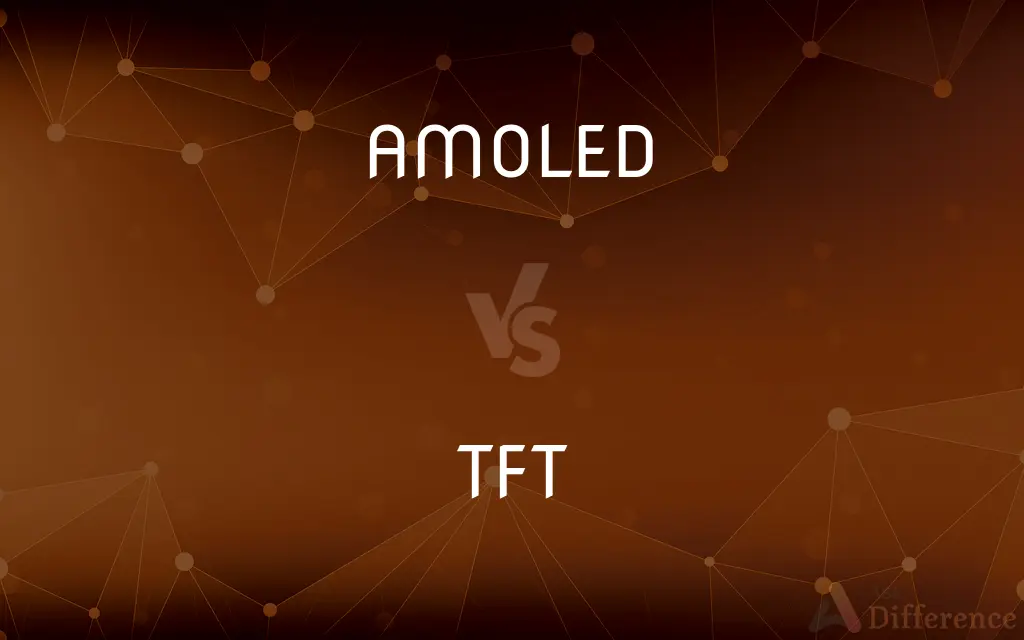AMOLED vs. TFT — What's the Difference?
By Tayyaba Rehman — Published on January 23, 2024
AMOLED (Active Matrix Organic Light Emitting Diode) is a display technology featuring thin, flexible screens with high contrast and color saturation. TFT (Thin Film Transistor) is a type of LCD technology that uses thin-film transistors for quality image.

Difference Between AMOLED and TFT
Table of Contents
ADVERTISEMENT
Key Differences
AMOLED displays use organic compounds that emit light when an electric current is applied, eliminating the need for a backlight. TFT, a variant of LCD technology, uses thin-film transistors to control individual pixels, requiring a backlight.
AMOLED screens are known for their superior contrast, with true blacks and vibrant colors, as each pixel emits its own light. TFT displays typically have lower contrast ratios and cannot achieve true black as AMOLEDs can.
Energy efficiency is higher in AMOLED displays since they light up individual pixels and not the entire screen. TFT screens, by contrast, are less energy-efficient as the backlight illuminates the entire screen.
AMOLED displays offer better viewing angles and faster refresh rates compared to TFT displays. TFT technology, however, is generally more cost-effective and widely used in various devices.
The thin and flexible nature of AMOLED screens allows for more innovative device designs, whereas TFT screens are more rigid and traditional in design.
ADVERTISEMENT
Comparison Chart
Display Technology
Organic compounds that emit light
Liquid crystal display with thin-film transistors
Contrast and Color
Higher contrast, true blacks, vibrant colors
Lower contrast, less vibrant blacks
Energy Efficiency
More energy-efficient, lights individual pixels
Less efficient, backlight illuminates the entire screen
Viewing Angles
Better viewing angles
Narrower viewing angles
Cost and Usage
Generally more expensive, used in high-end devices
More cost-effective, widely used in various devices
Compare with Definitions
AMOLED
Known for deep blacks and high contrast.
Watching movies on an AMOLED screen is a visual treat.
TFT
Requires backlighting for visibility.
The backlight in TFT screens ensures consistent brightness.
AMOLED
Provides superior viewing angles.
The AMOLED display ensures clear viewing from different angles.
TFT
Has narrower viewing angles.
Colors on the TFT screen shift when viewed from the side.
AMOLED
Offers flexible screen potential.
The new foldable phone utilizes AMOLED technology.
TFT
More cost-effective than AMOLED.
Manufacturers often choose TFT for its affordability.
AMOLED
A display with self-illuminating pixels.
The AMOLED screen on her phone provided vivid images.
TFT
Commonly used in standard devices.
Most budget smartphones have TFT screens.
AMOLED
Energy-efficient display technology.
His smartwatch uses AMOLED for its battery efficiency.
TFT
A type of LCD with thin-film transistors.
The TFT display on her tablet produces clear images.
Common Curiosities
Can AMOLED displays show true black?
Yes, AMOLED can display true black as individual pixels can turn off completely.
Why do manufacturers use TFT displays in budget devices?
TFT displays are more cost-effective, making them suitable for budget devices.
Is image burn-in a concern with AMOLED screens?
Yes, AMOLED screens can experience burn-in over time, where images persist on the screen.
Are TFT displays less energy-efficient than AMOLED?
Yes, because TFTs use a backlight to illuminate the entire screen, making them less energy-efficient.
Are AMOLED displays better for battery life?
Generally, yes, as AMOLED displays only light up the required pixels.
Why do TFT screens have narrower viewing angles?
The nature of TFT technology causes color shifts and reduced visibility at wider angles.
What is the primary advantage of AMOLED over TFT?
AMOLED offers higher contrast, true blacks, and more vibrant colors.
Do professional graphic designers prefer AMOLED or TFT?
Professional designers often prefer AMOLED for its color accuracy and contrast.
Can TFT displays be used in flexible devices?
No, TFT displays are more rigid and not suitable for flexible device designs.
Are colors more vibrant on AMOLED or TFT?
Colors are more vibrant on AMOLED screens due to their individual pixel illumination.
How does the backlight in a TFT display work?
The backlight in a TFT display illuminates the liquid crystals to create images.
Is the cost the only downside of AMOLED?
Cost is a significant factor, along with potential for burn-in issues.
Is the repair cost higher for AMOLED screens?
Yes, repairing an AMOLED screen is generally more expensive than a TFT screen.
Can AMOLED be used for large screen devices like TVs?
Yes, AMOLED is increasingly being used in large screen devices like TVs.
Are TFT displays better in bright sunlight?
TFT displays can perform better in bright conditions due to their backlight.
Share Your Discovery

Previous Comparison
HTML vs. XHTML
Next Comparison
EarPods vs. AirPodsAuthor Spotlight
Written by
Tayyaba RehmanTayyaba Rehman is a distinguished writer, currently serving as a primary contributor to askdifference.com. As a researcher in semantics and etymology, Tayyaba's passion for the complexity of languages and their distinctions has found a perfect home on the platform. Tayyaba delves into the intricacies of language, distinguishing between commonly confused words and phrases, thereby providing clarity for readers worldwide.












































